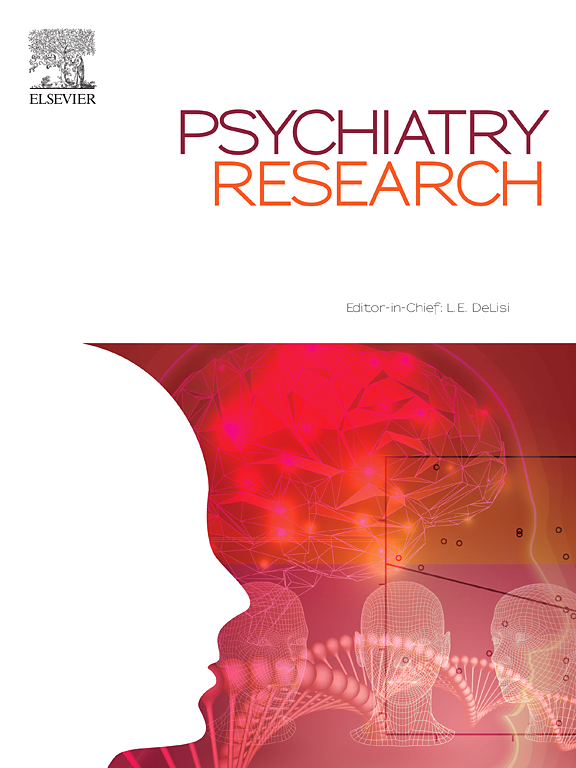Neural basis of GAD improvement following a mindfulness-based intervention and antidepressant treatment: an analysis from a randomized controlled trial
IF 4.2
2区 医学
Q1 PSYCHIATRY
引用次数: 0
Abstract
Background
The brain mechanisms underlying patient improvement after interventions remain poorly understood. Identifying the shared and distinct neural pathway between improvement mechanisms across distinct treatment modalities might improve our understanding of brain-behavior relationships and inform personalized approaches.
Aims
To investigate the neural correlations of symptom improvement in Generalized Anxiety Disorder (GAD) by examining changes in brain functional connectivity (FC) following two distinct treatments: mindfulness (body-in-mind training, BMT) and fluoxetine (FLX).
Method
Twenty GAD patients from a randomized clinical trial underwent resting-state fMRI before and after their respective interventions. FC of the amygdala with the prefrontal cortex, Default Mode (DMN), and Salience Network (SN) was analyzed. Regression analyses assessed the relationship between symptom improvement and amygdala-related FC changes.
Results
Increased FC between the left amygdala and right orbitofrontal cortex (OFC) was found after the interventions and associated with symptom improvement. Treatment-specific patterns of connectivity emerged: in the BMT group, symptom improvement correlated with amygdala connectivity to the DMN and SN, whereas in the FLX group, improvement was linked to amygdala-OFC coupling. However, interaction analysis did not reveal significant differences between groups.
Conclusion
Symptom improvement in GAD may involve enhanced functional coupling between brain regions and circuits critical for emotional regulation, self-referential processing, and stimulus selection, particularly between the left amygdala and right OFC. Larger sample studies are needed to elucidate treatment-specific neural mechanisms and refine personalized therapeutic strategies.
正念干预和抗抑郁治疗后广泛性焦虑症改善的神经基础:来自一项随机对照试验的分析
背景:干预后患者改善的脑机制仍然知之甚少。在不同治疗方式的改善机制之间确定共享和独特的神经通路可能会提高我们对大脑-行为关系的理解,并为个性化治疗提供信息。目的通过观察正念(身心训练,BMT)和氟西汀(FLX)两种不同治疗后脑功能连通性(FC)的变化,探讨广泛性焦虑障碍(GAD)症状改善的神经相关性。方法随机选取20例GAD患者,在干预前后分别进行静息态fMRI检查。分析了杏仁核与前额皮质、默认模式(DMN)和显著性网络(SN)的FC。回归分析评估了症状改善与杏仁核相关FC变化之间的关系。结果干预后发现左侧杏仁核和右侧眶额皮质(OFC)之间的FC增加,并与症状改善相关。出现了治疗特异性连接模式:在BMT组中,症状改善与杏仁核与DMN和SN的连接相关,而在FLX组中,改善与杏仁核- ofc耦合有关。然而,交互作用分析并没有显示组间的显著差异。结论广泛性焦虑症的症状改善可能与情绪调节、自我参照加工和刺激选择关键脑区和回路之间的功能耦合增强有关,特别是左杏仁核和右OFC之间的功能耦合。需要更大样本的研究来阐明治疗特异性的神经机制和完善个性化的治疗策略。
本文章由计算机程序翻译,如有差异,请以英文原文为准。
求助全文
约1分钟内获得全文
求助全文
来源期刊

Psychiatry Research
医学-精神病学
CiteScore
17.40
自引率
1.80%
发文量
527
审稿时长
57 days
期刊介绍:
Psychiatry Research offers swift publication of comprehensive research reports and reviews within the field of psychiatry.
The scope of the journal encompasses:
Biochemical, physiological, neuroanatomic, genetic, neurocognitive, and psychosocial determinants of psychiatric disorders.
Diagnostic assessments of psychiatric disorders.
Evaluations that pursue hypotheses about the cause or causes of psychiatric diseases.
Evaluations of pharmacologic and non-pharmacologic psychiatric treatments.
Basic neuroscience studies related to animal or neurochemical models for psychiatric disorders.
Methodological advances, such as instrumentation, clinical scales, and assays directly applicable to psychiatric research.
 求助内容:
求助内容: 应助结果提醒方式:
应助结果提醒方式:


